冀教版小学英语三3年级下册3英JJ Unit 4 Lesson 21 In the Restaurant课后作业练习测试试卷
【冀教版】小学英语3-6年级(三年级起点)教材目录
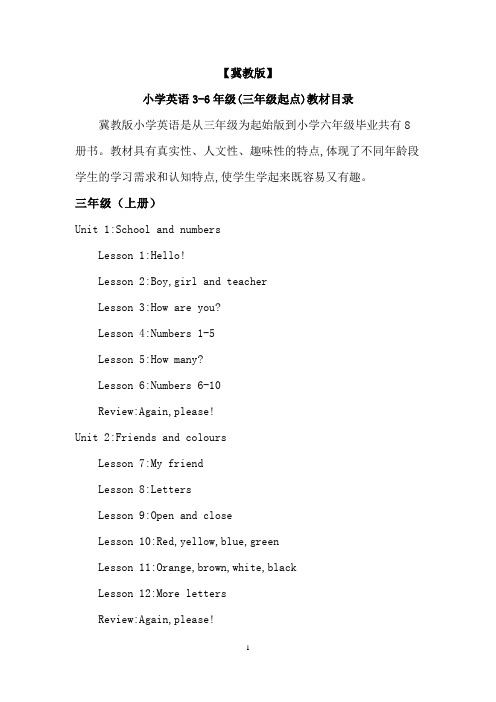
【冀教版】小学英语3-6年级(三年级起点)教材目录冀教版小学英语是从三年级为起始版到小学六年级毕业共有8册书。
教材具有真实性、人文性、趣味性的特点,体现了不同年龄段学生的学习需求和认知特点,使学生学起来既容易又有趣。
三年级(上册)Unit 1:School and numbersLesson 1:Hello!Lesson 2:Boy,girl and teacherLesson 3:How are you?Lesson 4:Numbers 1-5Lesson 5:How many?Lesson 6:Numbers 6-10Review:Again,please!Unit 2:Friends and coloursLesson 7:My friendLesson 8:LettersLesson 9:Open and closeLesson 10:Red,yellow,blue,greenLesson 11:Orange,brown,white,blackLesson 12:More lettersReview:Again,please!Unit 3:Feelings and bodyLesson 13:How do you feel?Lesson 14:My bodyLesson 15:Left and rightLesson 16:Warm and coolLesson 17:Are you Okay?Lesson 18:Look at me!Review:Again,please!Unit 4:FamilyLesson 19:FamilyLesson 20:Li Ming's familyLesson 21:Jenny's familyLesson 22:How old are you?Lesson 23:Happy birthday!Lesson 24:Lynn sees a doctorReview:Again,please!三年级(下册)Unit 1:Animals on the farmLesson 1:On the farmLesson 2:Cats and dogsLesson 3:Fish and birdsLesson 4:Horses and rabbitsLesson 5:Where?Lesson 6:Can I help you?Review:Again,please!Unit 2:Animals at the zooLesson 7:At the zooLesson 8:Tigers and bearsLesson 9:How many?Lesson 10:Where do they live?Lesson 11:What do they eat?Lesson 12:The clever monkeyReview:Again,please!Unit 3:Food and mealsLesson 13:I'm hungry!Lesson 14:Would you like some soup?Lesson 15:What's your favourite food?Lesson 16:Breakfast, lunch and Dinner Lesson 17:What's for breakfast?Lesson 18:The magic stoneReview:Again,please!Unit 4:Food and restaurantsLesson 19:Food and restaurantsLesson 20:Hamburgers and hot dogsLesson 21:In the restaurantLesson 22:How much is it?Lesson 23:How much are they?Lesson 24:A little monkeyReview:Again,please!四年级(上册)Unit 1:The clothes we wearLesson 1:Skirt and trousersLesson 2:New and oldLesson 3:Coat and scarfLesson 4:Shoes and socksLesson 5:Days of the weekLesson 6:Betty's clothesReview:Again,please!Unit 2:At homeLesson 7:HomeworkLesson 8:TV and phoneLesson 9:In the bedroomLesson 10:Brush and washLesson 11:ToysLesson 12:John and JackReview:Again,please!Unit 3:Let's go!Lesson 13:At schoolLesson 14:Near and farLesson 15:In the cityLesson 16:Cars and busesLesson 17:I'm lost!Lesson 18:Lost in the cityReview:Again,please!Unit 4:Shopping in the cityLesson 19:Let's go shopping!Lesson 20:At the shopLesson 21:Cinema and parkLesson 22:At the supermarketLesson 23:Shopping onlineLesson 24:Etta's teddy bearReview:Again,please!四年级(下册)Unit 1:Hello again!Lesson 1:How are you?Lesson 2:Is this your pencil?Lesson 3:Where are they?Lesson 4:How many books are there?Lesson 5:Where is Danny?Lesson 6:Where is Danny?Review:Again,please!Unit 2:Days and monthsLesson 7:Monts of the yearLesson 8:First,second,thirdLesson 9:When is it?Lesson 10:Rain and sunLesson 11:How's the weather today?Lesson 12:Mr. Moon's birthdayReview:Again,please!Unit 3:All about meLesson 13:How old are you?Lesson 14:Are you short or tall?Lesson 15:Where do you live?Lesson 16:How do you go to school?Lesson 17:What do you like to do?Lesson 18:Maddy the monsterReview:Again,please!Unit 4:My favouritesLesson 19:My favourite coloursLesson 20:My favourite clothesLesson 21:My favourite foodLesson 22:My favourite subjectLesson 23:My favourite school workLesson 24:The DiffosReview:Again,please!五年级(上册)Unit 1:My familyLesson 1:Li Ming's big familyLesson 2:What do they look like?Lesson 3:What do they do?Lesson 4:What do they like to do?Lesson 5:Having fun togetherLesson 6:Maddy's familyReview:Again,please!Unit 2:My country and English-speaking countries Lesson 7:ChinaLesson 8:CanadaLesson 9:The U.S.Lesson 10:The U.K.Lesson 11:AustraliaLesson 12:Maddy's family photosReview:Again,please!Unit 3:A travel planLesson 13:Beijing is great!Lesson 14:May I go to Beijing?Lesson 15:May I invite Danny and Jenny?Lesson 16:How can we go to Beijing?Lesson 17:The travel planLesson 18:Billy BeeReview:Again,please!Unit 4:Jenny and Danny come to ChinaLesson 19:Meet Li Ming's familyLesson 20:The Spring Festival is coming!Lesson 21:What year is it?Lesson 22:Special holidays in ChinaLesson 23:What do we need for the trip?Lesson 24:Year animalsReview:Again,please!五年级(下册)Unit 1:Going to BeijingLesson 1:I am excited!Lesson 2:What are you doing?Lesson 3:Who is singing?Lesson 4:Who is hungry?Lesson 5:What are they doing?Lesson 6:Danny is lost!Review:Again,please!Unit 2:In BeijingLesson 7:Arriving in BeijingLesson 8:Tian'anmen SquareLesson 9:The Palace MuseumLesson 10:The Great WallLesson 11:Shopping in BeijingLesson 12:Danny is lost!Review:Again,please!Unit 3:Writing homeLesson 13:Let's buy postcards!Lesson 14:Jenny writes a postcardLesson 15:Sending the postcardsLesson 16:An email is fastLesson 17:Danny's emailLesson 18:Little Zeke sends an emailReview:Again,please!Unit 4:Did you have a nice trip?Lesson 19:Li Ming comes homeLesson 20:Jenny goes homeLesson 21:Look at the photos!Lesson 22:Gifts for everyoneLesson 23:An email from Li MingLesson 24:A gift for little ZekeReview:Again,please!六年级(上册)Unit 1:Li Ming goes to Li Ming meets Jenny's class Lesson 1:At the airportLesson 2:Jenny's HouseLesson 3:Making breakfastLesson 4:Making dinnerLesson 5:In the living roomLesson 6:Baby Becky at homeReview:Again,please!Unit 2:School in Li Ming meets Jenny's class Lesson 7:On the school busLesson 8:Li Ming meets Jenny's classLesson 9:Mr. Wood teaches a science lessonLesson 10:How many are there?Lesson 11:Always do your homework!Lesson 12:Baby Becky at home photosReview:Again,please!Unit 3:Winter in CanadaLesson 13:SeasonsLesson 14:Snow!It's winter!Lesson 15:Winter funLesson 16:A skating lessonLesson 17:I like all seasons!Lesson 18:The snowmanReview:Again,please!Unit 4:Jenny and Danny come to On the school bus Lesson 19:Christmas is coming!Lesson 20:Christmas treeLesson 21:Christmas cardsLesson 22:Special holidays in On the school bus Lesson 23:It's Christmas morning!Lesson 24:Maddy's ChristmasReview:Again,please!六年级(下册)Unit 1:SportsLesson 1:Ping-pong and basketballLesson 2:At the sports shopLesson 3:Let's try!Lesson 4:Did you have fun?Lesson 5:A basketball gameLesson 6:A famous football playerReview:Again,please!Unit 2:Good health to you!Lesson 7:Always have breakfast!Lesson 8:Always brush your teeth!Lesson 9:Eat more vegetables and fruit!Lesson 10:ExerciseLesson 11:Work hard!Lesson 12:Hellen KellerReview:Again,please!Unit 3:What will you do this summer?Lesson 13:Summer is coming!Lesson 14:Tomorrow we will playLesson 15:Jenny's summer holidayLesson 16:Li Ming's summer holidayLesson 17:Danny's summer holidayLesson 18:Three kites in the skyReview:Again,please!Unit 4:Li Ming comes homeLesson 19:Buying giftsLesson 20:Looking at photosLesson 21:A party for Li MingLesson 22:Surprise!Lesson 23:Good-bye!Lesson 24:Danny's surprise cakeReview:Again,please!。
冀教版四年级下册英语教案:Unit4Lesson21MyFavouriteFood
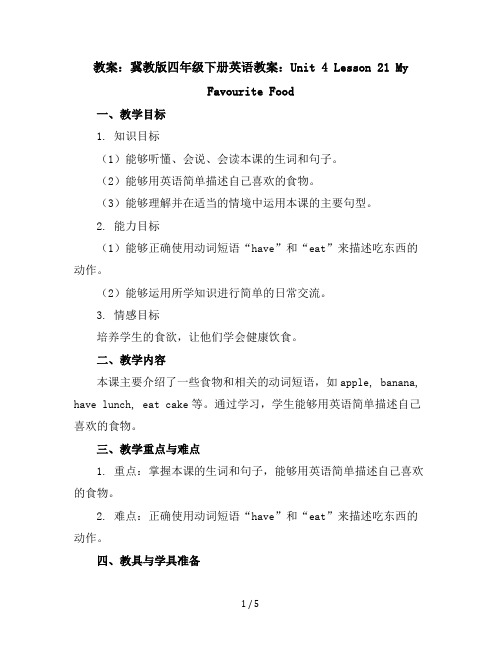
教案:冀教版四年级下册英语教案:Unit 4 Lesson 21 MyFavourite Food一、教学目标1. 知识目标(1)能够听懂、会说、会读本课的生词和句子。
(2)能够用英语简单描述自己喜欢的食物。
(3)能够理解并在适当的情境中运用本课的主要句型。
2. 能力目标(1)能够正确使用动词短语“have”和“eat”来描述吃东西的动作。
(2)能够运用所学知识进行简单的日常交流。
3. 情感目标培养学生的食欲,让他们学会健康饮食。
二、教学内容本课主要介绍了一些食物和相关的动词短语,如apple, banana, have lunch, eat cake等。
通过学习,学生能够用英语简单描述自己喜欢的食物。
三、教学重点与难点1. 重点:掌握本课的生词和句子,能够用英语简单描述自己喜欢的食物。
2. 难点:正确使用动词短语“have”和“eat”来描述吃东西的动作。
四、教具与学具准备1. 教具:多媒体课件、食物图片、食物卡片。
2. 学具:笔记本、彩色笔。
五、教学过程1. 导入(1)教师出示各种食物图片,引导学生说出食物的名称。
(2)学生用英语简单描述自己喜欢的食物。
2. 课堂展示(1)教师播放课文动画,学生跟读并模仿。
(2)学生分角色扮演,表演课文对话。
3. 单词教学(1)教师出示食物卡片,引导学生读出生词。
(2)学生用生词造句,巩固记忆。
4. 句型练习(1)教师引导学生运用本课句型进行小组讨论。
(2)学生上台展示讨论成果。
5. 巩固练习(1)教师出示食物图片,学生用英语描述。
(2)学生分组进行角色扮演,运用本课知识进行交流。
6. 课堂小结六、板书设计板书设计如下:Unit 4 Lesson 21 My Favourite Food1. 生词:apple, banana, cake, rice, have lunch, eat2. 句型:What's your favourite food? I like七、作业设计1. 抄写生词,每个单词写5遍。
四年级上册英语Unit 4 Lesson 21 Cinema and Park冀教版三起

四年级上册英语Unit 4 Lesson 21 Cinema and Park 冀教版(三起)一、课文内容1.1 DialoguesDialogue 1A: Do you like going to the cinema, Miss White?B: Yes, I do. I like going to the cinema.A: Do you like watching cartoons?B: No, I don’t like watching cartoons very much. I like watching films.A: What kind of films do you like?B: I like action films and comedies.A: Do you like horror films?B: No, I don’t like horror films at all.Dialogue 2A: Hi, Tony. What are you doing this afternoon?B: Hi, Daisy. I’m going to the par k.A: Great! I’m going to the park too. Do you want to go together?B: Sure. Let’s go together.A: What do you like to do in the park?B: I like playing football and flying kites.A: I like playing basketball and having picnics.B: That’s great. We can do all those things.1.2 Vocabulary1.cinema 电影院2.watch 观看3.cartoons 卡通片4.films 电影5.action films 动作片edies 喜剧片7.horror films 恐怖片8.park 公园9.together 一起10.football 足球11.kites 风筝12.basketball 篮球13.picnics 野餐1.3 Patterns1.Do you like going to the cinema?2.I like watching films.3.What kind of films do you like?4.I like action films and comedies.5.What do you like to do in the park?6.I like playing football and flying kites.二、课文点拨本课讲的是电影和公园。
三年级下册英语教案-Lesson21IntheRestaurant∣冀教版

教案:三年级下册英语教案 Lesson 21 In the Restaurant |冀教版教学目标:1. 能够听懂、会说、会读本节课的生词和句子。
2. 能够用英语简单描述在餐厅里的食物和饮料。
3. 能够用英语进行简单的点餐和回答点餐的问题。
4. 培养学生的听说能力和交际能力。
教学内容:1. 生词:restaurant(餐厅),menu(菜单),food(食物),drink(饮料),chicken(鸡肉),beef(牛肉),noodles(面条),soup(汤),rice(米饭),water(水),tea(茶),coffee(咖啡)。
2. 句子: What would you like?(你想要什么?) I wouldlike somechicken./beef./noodles./soup./rice./water./tea./coffee.(我想要一些鸡肉/牛肉/面条/汤/米饭/水/茶/咖啡。
) Here is your(这是你的)。
教学重点与难点:1. 重点:能够用英语简单描述在餐厅里的食物和饮料,进行简单的点餐和回答点餐的问题。
2. 难点:单词的准确发音和记忆,句子的运用和回答。
教具与学具准备:1. 教具:PPT,卡片,食物和饮料的实物或图片。
2. 学具:课本,练习本,笔。
教学过程:1. 热身(5分钟)教师与学生用英语进行简单的问候和交流。
引导学生回顾上一节课学到的内容,如食物和饮料的名称。
2. 引入(10分钟)教师出示餐厅的图片,引导学生猜测今天的主题。
教师出示食物和饮料的实物或图片,引导学生用英语描述。
3. 呈现(15分钟)教师通过PPT展示本节课的生词和句子。
教师用英语解释生词和句子的意思,并进行示范。
学生跟读生词和句子,教师纠正发音。
4. 练习(10分钟)教师出示食物和饮料的卡片,学生用英语说出它们的名称。
教师引导学生进行角色扮演,模拟在餐厅点餐的情景。
5. 巩固(5分钟)教师出示一个餐厅的场景图,学生用英语描述里面的食物和饮料。
四年级下册英语教案-Unit 4 Lesson 21 My Favourite Food∣冀教版 (
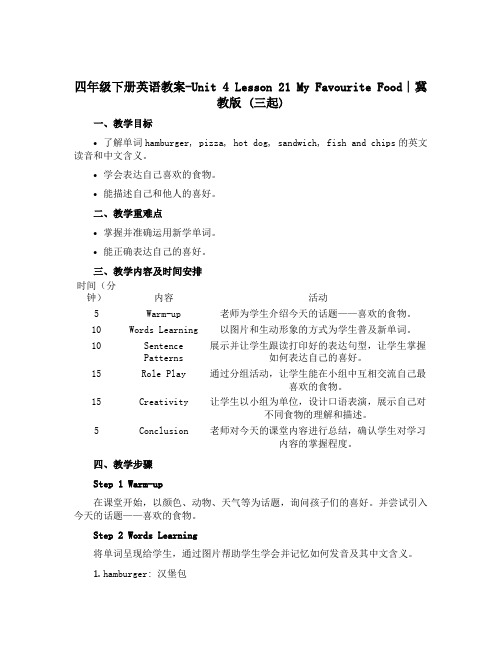
四年级下册英语教案-Unit 4 Lesson 21 My Favourite Food∣冀教版 (三起)一、教学目标•了解单词hamburger, pizza, hot dog, sandwich, fish and chips的英文读音和中文含义。
•学会表达自己喜欢的食物。
•能描述自己和他人的喜好。
二、教学重难点•掌握并准确运用新学单词。
•能正确表达自己的喜好。
三、教学内容及时间安排时间(分钟)内容活动5Warm-up老师为学生介绍今天的话题——喜欢的食物。
10Words Learning以图片和生动形象的方式为学生普及新单词。
10SentencePatterns 展示并让学生跟读打印好的表达句型,让学生掌握如何表达自己的喜好。
15Role Play通过分组活动,让学生能在小组中互相交流自己最喜欢的食物。
15Creativity让学生以小组为单位,设计口语表演,展示自己对不同食物的理解和描述。
5Conclusion老师对今天的课堂内容进行总结,确认学生对学习内容的掌握程度。
四、教学步骤Step 1 Warm-up在课堂开始,以颜色、动物、天气等为话题,询问孩子们的喜好。
并尝试引入今天的话题——喜欢的食物。
Step 2 Words Learning将单词呈现给学生,通过图片帮助学生学会并记忆如何发音及其中文含义。
1.hamburger: 汉堡包2.pizza: 披萨3.hot dog: 热狗4.sandwich: 三明治5.fish and chips: 炸鱼薯条Step 3 Sentence Patterns在黑板上展示并逐一注解以下表达句型1.What’s your favourite food?2.My favourite food is hamburger.3.Do you like pizza?4.Yes, I do. / No, I don’t.要求学生提高听、说的能力,模仿跟读以掌握表达的发音和语调。
冀教版英语三年级下册 unit 4全套单元课件

我喜欢苹果。我想吃一个。
you‘re
(you are 的缩写形式) 你(们)是
【例句】You're our good teacher. 你是我们的好老师。
【注意】 are用在复数人称后,也可用在其他名词 复数形式后面。
【复数】 apples 【详解】苹果前面用冠词an,一个 苹果an apple. 【例句】 I have an apple.
我有一个苹果。
The apple is very sweet.
Try 苹果很甜。
orange 橘子
【复数】 oranges 【详解】意为橘子为可数名词;意为 橘色为不可数名词。 【例句】 There are some oranges.
那是我想要的。
A donut and some milk.
That's what I'd like.
may 可以;可能
【用法】may是情态动词,后面跟动词原形,没有人 称和数的变化。把may提到句首可以变成疑问句。
【例句】May I use your ruler? 我可以用你的尺子吗?
one 一个
冀教版(三年级起点)三年级下册
Lesson 19 I Like Fruit!
Warm-up/Revision
Presentation
● What do you like? ● Let's sing ● How many?
Test
Sum-up
Homework
Warm-up/Revision
Do you like fruit?
三年级英语下册 Unit 3 Lesson 21(1)教学反思 冀教版
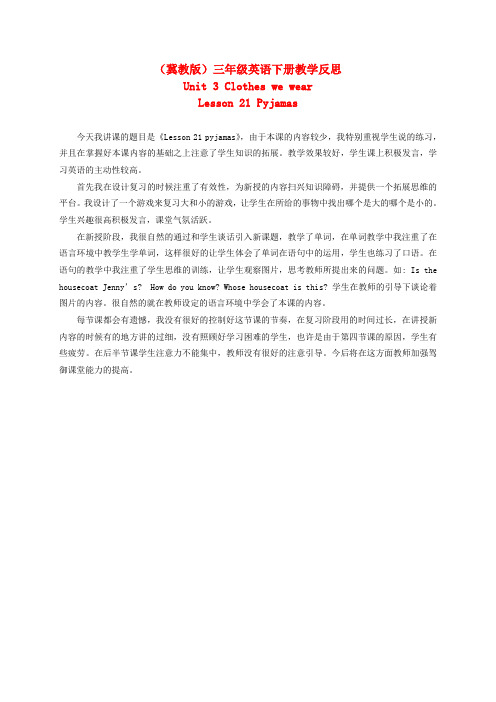
(冀教版)三年级英语下册教学反思
Unit 3 Clothes we wear
Lesson 21 Pyjamas
今天我讲课的题目是《Lesson 21 pyjamas》,由于本课的内容较少,我特别重视学生说的练习,并且在掌握好本课内容的基础之上注意了学生知识的拓展。
教学效果较好,学生课上积极发言,学习英语的主动性较高。
首先我在设计复习的时候注重了有效性,为新授的内容扫兴知识障碍,并提供一个拓展思维的平台。
我设计了一个游戏来复习大和小的游戏,让学生在所给的事物中找出哪个是大的哪个是小的。
学生兴趣很高积极发言,课堂气氛活跃。
在新授阶段,我很自然的通过和学生谈话引入新课题,教学了单词,在单词教学中我注重了在语言环境中教学生学单词,这样很好的让学生体会了单词在语句中的运用,学生也练习了口语。
在语句的教学中我注重了学生思维的训练,让学生观察图片,思考教师所提出来的问题。
如: Is the housecoat Jenny’s? How do you know? Whose housecoat is this? 学生在教师的引导下谈论着图片的内容。
很自然的就在教师设定的语言环境中学会了本课的内容。
每节课都会有遗憾,我没有很好的控制好这节课的节奏,在复习阶段用的时间过长,在讲授新内容的时候有的地方讲的过细,没有照顾好学习困难的学生,也许是由于第四节课的原因,学生有些疲劳。
在后半节课学生注意力不能集中,教师没有很好的注意引导。
今后将在这方面教师加强驾御课堂能力的提高。
Unit 4 Lesson 21 Christmas Cards(教学设计) 冀教版(三起)英语六年

Unit 4 Lesson 21 Christmas Cards(教学设计)——冀教版(三起)英语六年级上册一、教学目标1.学生能够理解并掌握本课生词:Christmas tree, present, Santa Claus, reindeer, card, message, envelope。
2.学生能够理解并掌握本课句型:What do you want for Christmas? I wanta present. What message do you want to write? Merry Christmas。
3.学生能够运用所学知识制作一张圣诞卡并写出自己想要的圣诞礼物和信息。
二、教学内容1.生词:Christmas tree, present, Santa Claus, reindeer, card, message, envelope。
2.句型:What do you want for Christmas? I want a present. What message do you want to write? Merry Christmas。
3.圣诞卡制作。
三、教学重点1.学生能够理解并掌握本课生词和句型。
2.学生能够运用所学知识制作一张圣诞卡并写出自己想要的圣诞礼物和信息。
四、教学难点1.学生能够熟练地制作一张圣诞卡并写出自己想要的圣诞礼物和信息。
2.学生能够用简单的语言表达圣诞节的相关内容。
五、教学准备1.PPT。
2.教材。
3.圣诞卡制作所需的材料。
4.计算机、打印机和墨水。
六、教学过程Step 1. Revision(复习)根据所学知识复习内容,可以利用PPT、单词卡片等方式进行复习。
Step 2. Presentation(呈现)1.引入生词:Christmas tree, present, Santa Claus, reindeer, card, message, envelope。
三年级英语下册优质教案- Lesson 21 In the Restaurant 冀教版
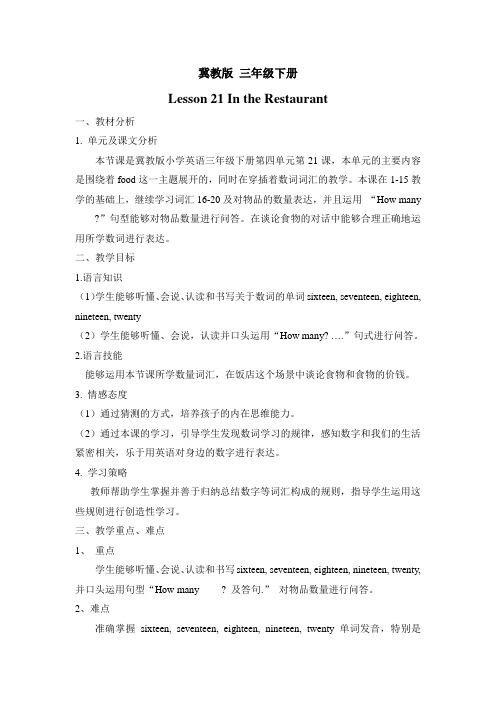
冀教版三年级下册Lesson 21 In the Restaurant一、教材分析1. 单元及课文分析本节课是冀教版小学英语三年级下册第四单元第21课,本单元的主要内容是围绕着food这一主题展开的,同时在穿插着数词词汇的教学。
本课在1-15教学的基础上,继续学习词汇16-20及对物品的数量表达,并且运用“How many ____?”句型能够对物品数量进行问答。
在谈论食物的对话中能够合理正确地运用所学数词进行表达。
二、教学目标1.语言知识(1)学生能够听懂、会说、认读和书写关于数词的单词sixteen, seventeen, eighteen, nineteen, twenty(2)学生能够听懂、会说,认读并口头运用“How many? ….”句式进行问答。
2.语言技能能够运用本节课所学数量词汇,在饭店这个场景中谈论食物和食物的价钱。
3. 情感态度(1)通过猜测的方式,培养孩子的内在思维能力。
(2)通过本课的学习,引导学生发现数词学习的规律,感知数字和我们的生活紧密相关,乐于用英语对身边的数字进行表达。
4. 学习策略教师帮助学生掌握并善于归纳总结数字等词汇构成的规则,指导学生运用这些规则进行创造性学习。
三、教学重点、难点1、重点学生能够听懂、会说、认读和书写sixteen, seventeen, eighteen, nineteen, twenty, 并口头运用句型“How many ____? 及答句.”对物品数量进行问答。
2、难点准确掌握sixteen, seventeen, eighteen, nineteen, twenty单词发音,特别是sixteen至nineteen的后缀发音和twenty的后缀发音要领。
四、教学步骤Step I Class Opening (2 minutes)1. Free talk (T-S)T: Are you ready for our class?S: Yes.T: Good morning!I have a big breakfast in the restaurant.Look! This is a restaurant.What’s in the restaurant?S: Tables and Chairs.[设计思路:互相问候,轻松开始本课的学习。
冀教版初三下册Unit 3 Pardon Me! Lesson 21 What's in a Name
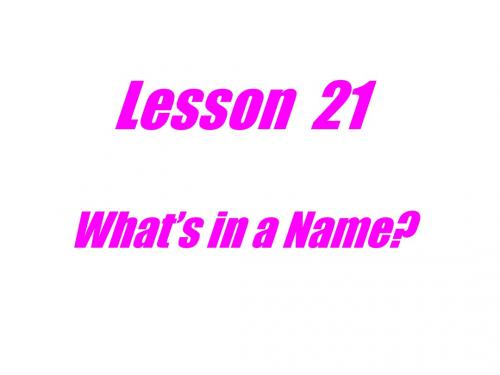
根据汉语意思完成句子,每空一词: 1. 世界上有许多不同的文化。 In the world there are many _________ different __________. cultures 2. 当客人们见面时,他们经常握手。 They often ______ shake _______ hands when the guests meet. 3. 我不是中国人,我来自外国。 I am not a _________. _______. Chinese I come from a ________ foreign country 4. 这两个国家有些文化差异。 These two countries have a few ________ cultural ____________. differences 5. 对于一些学生来说,科学是很难理解的。 Science is ___ too difficult for some students ___understand. to 6. 我听了但什么也没听见。 I __________ listened but ________ heard nothing.
冀教版(三起)英语五年级下册课课件Unit4Lesson 21 Look at the Photos

Vocabulary
Photo[ˈfəʊtəʊ] 照片
Vocabulary
Was[wəz; wɒz] 是,存在(am is 的过去式)
Vocabulary
Happy [ˈhæ pi] 快乐的,开心的
Is and was
He is eight years old this year.
I am happy today.
The trees ___a_re____ __s_m__a_ll__ ___n_o_w___. 3. Li Ming is short this year. (用“in 2008”改为一般过去时)
Li Ming ___w__as___ ____sh_o_r_t_ ____i_n___ __2_0_0_8___. 4. We were very happy yesterday. (改为否定句) __W__e_w__e_re__n_o_t_v_e_ry__h_a_p_p_y_y_e_s_t_er_d_a_y_.____________________ 5. Did you go to the library last week?(作否定回答) ___N_o_,_I_/w__e_d_i_d_n_’t_. ___________________________________
B. sad
C. photo
( A ) 2. Danny was seven years old last year.
A. were
B. is
Hale Waihona Puke C. are( A ) 3. I hurt my leg last week.
A. month
B. mouth
C. yesterday
冀教版三起英语六年级下册Unit 4 Lesson 21 A Party for Li Ming课件

Okay! I will invite some friends.
聚会;晚会
They will have a good-bye party for Li Ming.
leaving 的用法
leaving 是动词leave的现在分词形式,它可以用 在一个现在进行时的句子中表示将来,意思是 “将要出发,将要离开 ”。 类似用法的词有:arrive, go, get, come等。
It’s five forty-five. He’s _l_a_t_e_.
Let’s make
Make an invitation card and talk about it.
Tip: The information should include what, when and
where.
Summary
例句:他们很快就会到这里了。 They’re arriving here soon.
Read and answer
1. Will they tell Li Ming about the party? No, they won’t. It’s a surprise for him.
告诉; 讲述
Will we tell Li Ming about the party?
Then I will be early! Jenny: Great! See you tomorrow!
How many people are coming to the party, Jenny?
Let’s see…you, me, Li Ming, Steven, Kim, my sister, Mr. wood, my mum an(d) my dad. Nine!
冀教版(三起)-英语-四年级上册-Unit4 Lesson21 Cinema and Park一课一练(含答案解析)
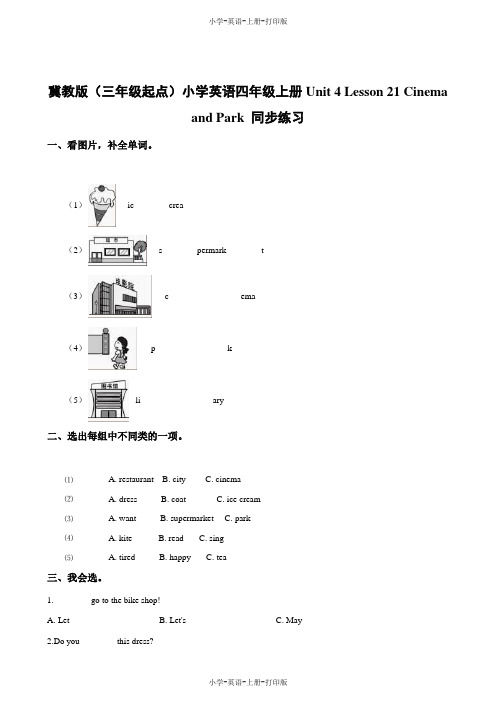
冀教版(三年级起点)小学英语四年级上册Unit 4 Lesson 21 Cinemaand Park 同步练习一、看图片,补全单词。
(1)ic________crea________(2)s________permark________t(3) c________ ________ema(4)p________ ________k(5) li________ ________ary二、选出每组中不同类的一项。
⑴________A. restaurant B. city C. cinema⑵________A. dress B. coat C. ice cream⑶________A. want B. supermarket C. park⑷________A. kite B. read C. sing⑸________A. tired B. happy C. tea三、我会选。
1.________ go to the bike shop!A. LetB. Let'sC. May2.Do you________ this dress?A. to likeB. want toC. lik3.Let's go to the cinema ________ a film.A. to readB. to seeC. to look4.I'm ________. I want to drink.A. thirstyB. hungryC. thirty5.I'm ________. I want to rest.A. hungryB. tiredC. thirsty四、判断英文表达下的图片是否正确。
1.Let's go to the cinema to see a film.()2.Let's go to the park to play football.()3.Let's go to the library to read books.()4.Let's go to the supermarket to buy some fruit.()5.Let's go to the restaurant to eat noodles.()五、句子排序帮下面的句子排排队,组成一段通顺的对话。
(冀教版)四年级英语下册《Unit 3 Lesson 21》教案设计
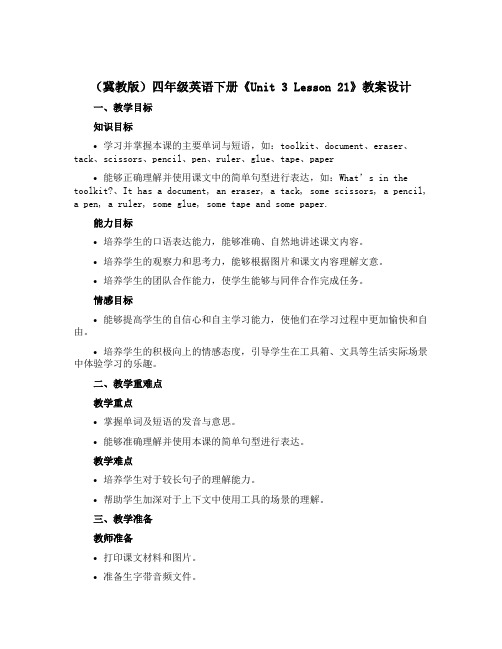
(冀教版)四年级英语下册《Unit 3 Lesson 21》教案设计一、教学目标知识目标•学习并掌握本课的主要单词与短语,如:toolkit、document、eraser、tack、scissors、pencil、pen、ruler、glue、tape、paper•能够正确理解并使用课文中的简单句型进行表达,如:What’s in the toolkit?、It has a document, an eraser, a tack, some scissors, a pencil, a pen, a ruler, some glue, some tape and some paper.能力目标•培养学生的口语表达能力,能够准确、自然地讲述课文内容。
•培养学生的观察力和思考力,能够根据图片和课文内容理解文意。
•培养学生的团队合作能力,使学生能够与同伴合作完成任务。
情感目标•能够提高学生的自信心和自主学习能力,使他们在学习过程中更加愉快和自由。
•培养学生的积极向上的情感态度,引导学生在工具箱、文具等生活实际场景中体验学习的乐趣。
二、教学重难点教学重点•掌握单词及短语的发音与意思。
•能够准确理解并使用本课的简单句型进行表达。
教学难点•培养学生对于较长句子的理解能力。
•帮助学生加深对于上下文中使用工具的场景的理解。
三、教学准备教师准备•打印课文材料和图片。
•准备生字带音频文件。
学生准备•完成上课前布置的预习任务。
四、教学过程步骤一:引入1.教师展示一张图片,让学生看一看图片说一说:–What’s in the picture?–What are they doing?2.引入本课主题:The Toolkit。
步骤二:学习新词汇1.教师将生字逐一呈现给学生,让学生跟读,并加深对生字的印象。
2.教师用图片介绍生字的发音和意思,帮助学生掌握新的单词和短语。
让学生跟读并完成作业。
步骤三:学习课文1.教师播放课文录音,让学生跟着录音读课文,并注意听每一个单词的发音。
【冀教版】 三年级上册英语- Unit4Lesson21 Jenny’s Family
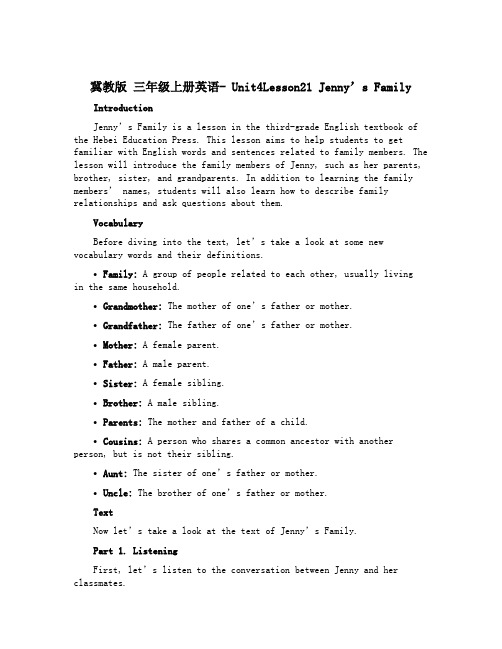
冀教版三年级上册英语- Unit4Lesson21 Jenny’s FamilyIntroductionJenny’s Family is a lesson in the third-grade English textbook of the Hebei Education Press. This lesson aims to help students to get familiar with English words and sentences related to family members. The lesson will introduce the family members of Jenny, such as her parents, brother, sister, and grandparents. In addition to learning the family members’ names, students will also learn how to describe family relationships and ask questions about them.VocabularyBefore diving into the text, let’s take a look at some new vocabulary words and their definitions.•Family: A group of people related to each other, usually livingin the same household.•Grandmother:The mother of one’s father or mother.•Grandfather:The father of one’s father or mother.•Mother: A female parent.•Father: A male parent.•Sister: A female sibling.•Brother: A male sibling.•Parents: The mother and father of a child.•Cousins: A person who shares a common ancestor with another person, but is not their sibling.•Aunt:The sister of one’s father or mother.•Uncle:The brother of one’s father or mother.TextNow let’s take a look at the text of Jenny’s Family.Part 1. ListeningFirst, let’s listen to the conversation between Jenny and he r classmates.Jenny: Hello, everyone! This is my family photo.Classmates: Wow! Your family is big. Who are these people?Jenny: They are my grandparents.Classmates: Who is this?Jenny: This is my father.Classmates: Who is that lady next to your father?Jenny: That’s my mother.Classmates: And who is this girl next to your brother?Jenny: She’s my sister.Classmates: Wow! You have a sister and a brother.Jenny: Yes, my sister’s name is Lily, and my brother’s name is Tom.Part 2. SpeakingNow let’s practic e some sentences about family members.Teacher: Who is he?Students: He is my father.Teacher: Who is she?Students: She is my mother.Teacher: Who is he?Students: He is my brother.Teacher: Who is she?Students: She is my sister.Part 3. WritingFinally, let’s practice writing sentences about a family photo.Here is a family photo. Please write sentences about the people in the photo.Family PhotoFamily Photo•That’s my father. He is tall and strong.•That’s my mother. She is beautiful and kind.•That’s my little brother. He is cute and naughty.•That’s my big sister. She is smart and funny.•That’s my grandfather. He is old and wise.•That’s my grandmother. She is gentle and lovely.ConclusionJenny’s Family is a fun and interactive lesson for third-grade English language learners. Through this lesson, students can learn vocabulary related to family members and how to ask and answer questions about their family members. The lesson encourages students to speak and write sentences about family members and allows students to practice their language skills in a fun and engaging way.。
三年级英语Unit 4 Family_Lesson21教案
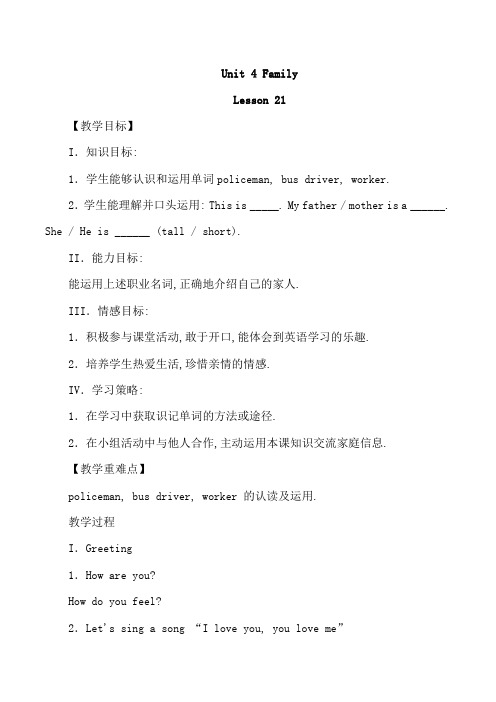
Unit 4 FamilyLesson 21【教学目标】I.知识目标:1.学生能够认识和运用单词policeman, bus driver, worker.2.学生能理解并口头运用: This is _____. My father / mother is a ______. She / He is ______ (tall / short).II.能力目标:能运用上述职业名词,正确地介绍自己的家人.III.情感目标:1.积极参与课堂活动,敢于开口,能体会到英语学习的乐趣.2.培养学生热爱生活,珍惜亲情的情感.IV.学习策略:1.在学习中获取识记单词的方法或途径.2.在小组活动中与他人合作,主动运用本课知识交流家庭信息.【教学重难点】policeman, bus driver, worker 的认读及运用.教学过程I.Greeting1.How are you?How do you feel?2.Let's sing a song “I love you, you love me”3.Review Li Ming's family.What is Li Ming?What is Li Ming's father/ mother?Match the words and pictures.II.Meet Jenny's family1.Show ppt, and ask:Who is it?Draw a family tree for Jenny's family.2.Introduce Jenny's family.“Canada”, read it please.Where do we live?What do they do? Listen to the tape.Show ppt6, introduce Jenny's sister.Who is it?What's her name?What is she?Is she tall or short?Who can read it?Show ppt7, introduce Jenny's brother. Ask the same questions. What is a policeman? Do actions to show us.Show ppt8, introduce Jenny's mother:Is there a driver in your family?How can a driver drive a bus? Can you show us?Show ppt9, introduce Jenny's father. Is your father a worker? Show ppt10 and ask: do you love your family?Read Part1in the student book.Check the understanding. Match.Learn to write the new words.III.Exercise1.Match the pictures and words.2.Practice: Pair work.Talk about Jenny's family.3.Group work.Talk about your family.Act out.Let's sing.Greet to the teacher.Sing a song “I love you, you love me”Answer the questions and review.Match.This is Jenny's____.Read Canada follow the teacher.We live in China.Listen and think.Answer the teacher's questions:This is Jenny's sister.Her name is Lynn.She is a student.She is short.Read this part.Answer the teacher's questionsDo actions and read it.Yes. I love my family.1.student2.policeman3.worker4.bus driverRead and write the new words on their exercise books. Match.1.doctor2.teacher3.student4.worker5.bus driver6.policemanTalk about Jenny's family with the new words.Introduce their family in groups.Act out.Change the words, Sing “I love you, you love me”.歌曲导入,营造轻松愉快的氛围.激活学生已有知识,为新课的学习做铺垫.帮助学生理清文本中人物间的关系.了解詹妮家的地理位置.带着问题听音,并在听后加以简单的小测试,引导学生认真听,养成边听边思考的好习惯.恰当的问题能降低阅读难度,帮助学生更好的理解文本.做动作来表达职业的特点,形象有趣.职业单词替换图片,回应上面的小测试,同时加深对新词的印象.当堂引导学生写单词,引导学生形成记忆单词的有效途径.新旧知识融合,降低干扰,为后面的运用做铺垫.练习使用新单词谈论有关家庭成员的话题.由二人学习到小组合作,由点到面增加了交流学习的机会,也利于引导学生形成有效的学习策略.改编歌曲,巩固知识,在愉悦的氛围中结束本课.【作业布置】Choose one or two to do:1.Introduce Jenny's family to your family.2.Introduce your family to your friends. 【板书设计】Unit 4 FamilyLesson21: Jenny's Family。
- 1、下载文档前请自行甄别文档内容的完整性,平台不提供额外的编辑、内容补充、找答案等附加服务。
- 2、"仅部分预览"的文档,不可在线预览部分如存在完整性等问题,可反馈申请退款(可完整预览的文档不适用该条件!)。
- 3、如文档侵犯您的权益,请联系客服反馈,我们会尽快为您处理(人工客服工作时间:9:00-18:30)。
Lesson 21 In the Restaurant
一、选出每组中不同类的一项。
() 1. A. B. C.
() 2. A. B. C.
() 3. A. B. C.
() 4. A. B. C.
() 5. A. B. C.
二、请你为快餐店算算账。
(写单词)
¥10 ¥6 ¥12
¥8 ¥4 ¥7
1. hamburger+juice=________ yuan
2. hot dog+milk=________ yuan
3. donut+juice=________ yuan
4. hot dog+coffee=________ yuan
5. hamburger+milk=________ yuan
6. donut+coffee=________ yuan
三、火眼金睛孙悟空。
() 1. I’d like some ________.
A. apple
B. water
C. noodle
() 2. Rice ________ delicious.
A. am
B. is
C. are
() 3. How many ________?
A. table
B. tables
C. a table
() 4. —What ________ you like?
—I’d like a pear.
A. do
B. are
C. would
() 5. —Would you like some water?
—________
A. Yes, I would.
B. No, please.
C. No, thanks.
四、情景交际。
() 1. 如果你想告诉大家你有二十支铅笔,你会怎么说?
A. I have twelve pencils.
B. I have twenty pencils.
() 2. 如果老师课上提问“13+5=?”,你怎么回答?
A. Eighteen.
B. Nineteen.
() 3. 当你在餐厅点餐时,如果你想要面条,你会怎么说?
A. I’d like some noodles.
B. I’d like some dumplings. () 4. 如果你想知道对方想不想喝果汁,你会怎么问?
A. Do you like juice?
B. Would you like some juice? () 5. 如果别人问你是不是想吃某种食物,你不想吃的时候会怎么说?
A. Yes, please.
B. No, thanks.
五、读问句,选答语。
() 1. How many pencils do you have?
() 2. What would you like?
() 3. Would you like some tea?
() 4. What do you like?
() 5. What’s your favourite fruit?
六、看图和菜单,补全对话,并算一算Jim和Lucy各花了多少钱。
noodles
juice
rice
Waiter:1. ________ would you 2. ________?
Jim: 3. ________ like some dumplings. What about you(你呢), Lucy? Lucy: I’d like some 4. ________.
Jim: 5. ________ 6. ________ like some juice?
Lucy: 7. ________, please.
Jim spends(花费) 8. ________ yuan.
Lucy spends 9. ________ yuan.
答案:
一、1. C 2. B 3. A 4. C 5. A
二、1. twenty 2. fourteen 3. fourteen
4. seventeen
5. sixteen
6. thirteen
三、1. B点拨:some后跟不可数名词或可数名词复数。
2. B点拨:rice不可数。
3. B
4. C
5. C
四、1. B 2. A 3. A 4. B 5. B
五、1. D 2. E 3. A 4. C 5. B
六、1. What 2. like 3. I’d 4. fish 5. Would 6. you7. Yes
8. sixteen9. twenty。
